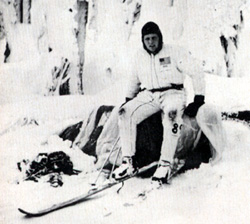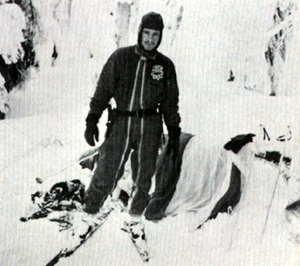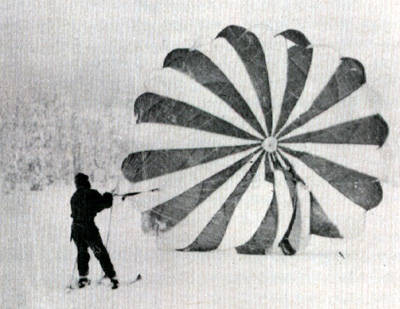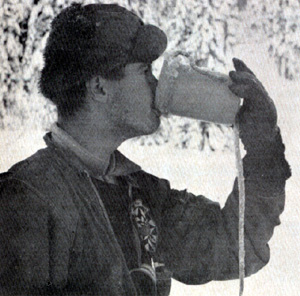Featured Exhibits
Sign up for the Newsletter
Advertise on ParachuteHistory.com
Disclaimer
Privacy Policy
About
Bored Jumpers do Something Different
Bored skydivers are always concocting new and different things to do. Tired of the hop-n-pops in December near Snohomish, WA, Bill Berg and Pete Goodwin decided to take a parachute expedition into the Cascade Mountains in 1963.Impulsive skydiver planning of the adventure took over. Their plan was simple. Jump into a clear area and then take two days to hike out.
They selected a meadow near Lake Janus that was 10 miles by trail from Stevens Pass. The lake had an elevation of 4200 ft.
Equipment and supplies were gathered and packaged into bundles to be dropped onto the site first.
The first two bundles were kit bags containing all the food, including hotcake mix, canned meat, powdered milk, cigarettes, matches, tea, coffee, sausage, bacon, sugar, a 35 mm camera and film. Eight-foot diameter cargo parachutes were rigged to these bundles.
Sleeping bags, clothing, hatchet, flashlight and 10 pounds of potatoes were part of a chuteless bundle.
Skis, poles and an un-assembled sled made up the forth bundle with another 8 ft. diameter cargo chute. The sled was a 4 ft. by 3 ft. sheet of aluminum with plywood side panels.
Since the jump was in December Berg and Goodwin wore heavy quilted ski clothing, wool shirts, pants, Pioneer coveralls, heavy jackets, ski boots, fur-lined pile caps and leather gloves with liners. They each carried a .22 caliber pistol and 50 rounds of ammunition. The guns were just in case they had to shoot something to eat.
Their parachute equipment consisted of B-4 containers, 28-ft. candy striped canopies with blank gores and T-7A reserves. The mains were static lined with T-10 deployment bags. They attached a hunting knife and 4 red smoke flares to the reserve.
The parachute equipment was old and they planned to leave it in the mountains. This was long before the days of pack out what you pack in.
The plane procured for this adventure was a 5-place Cessna 170 with the Snohomish jump door.
After all this planning and assembly of equipment they had to wait two days for the weather to clear. Finally on Monday, December 16, 1963 the sun poked out and they were on their way.
They took off from Snohomish, about 50 miles from Lake Janus, for a 30 minute ride. The first passes at the frozen lake were at 200 ft. AGL. They dropped the supplies and spotted well. The bundles landed 200-300 feet apart. The chuteless bundle made a big crater near the base of a fir tree.
Tom Barr , the pilot, climbed higher for the human cargo. Bill Berg was the first jumper. He also carried a carton of eggs in his left hand. Bill carefully climbed out on the strut - clutching the carton of eggs. Near the end of the lake, he let go and fell into the icy air.
His parachute opened and Pete pulled in the static line. Bill landed 500 ft. up the side of Jove Peak in a small clearing.
Pete had about 500 more feet of altitude for his jump and was made a bit further upwind. He tried slipping the parachute over to the clearing Bill landed in. He did not quite make it. His canopy snagged a tree. When he came to a stop he was about 40 feet from the ground. He dropped his reserve, grabbed hold of the tree and released himself from the main. He climbed down and jumped into six feet of snow.
The plane circled around to make sure they were ok.
Bill and Pete spent the rest of the afternoon collecting the equipment and supplies. The snow was knee deep and made for tough going.
They got to the bundle with the sled and skis. The sled was assembled quickly and then they tried their hand at skiing. Bill knew a little about skiing and Pete even less. This did not deter them in the least. After a few minutes of slipping and sliding they got the hang of it.
They stacked the other bundles on the sled. There was a rope from each front side of the sled to each man. The idea was to pull the sled behind them. The deep snow made this impossible. They ended up skiing the length of the rope and then pulling the sled up to them. They repeated this over and over to make progress in their journey in 20 to 30 foot increments at a time.
They had hoped to reach a nearby cabin before nightfall. The deep snow and brush impeded their progress. They decided to stay the night nearby. They found a hollowed out spot near a fallen tree. They laid their skis and poles against the tree. Bill's canopy was draped over to create a tent. The reserves were used for the floor of their tent. The bundles closed off the doorway.
They tried to sleep that night, but the cold kept them up.
 On Tuesday morning, they awoke to frozen boots and coveralls. Their body heat melted the snow under them and water was seeping into their sleeping bags. The bundles in the doorway were covered with snow. They could only get a small kindling type fire going. They gave up quickly on that.
On Tuesday morning, they awoke to frozen boots and coveralls. Their body heat melted the snow under them and water was seeping into their sleeping bags. The bundles in the doorway were covered with snow. They could only get a small kindling type fire going. They gave up quickly on that.
Next, Bill wanted to fire off a round from his gun. It was frozen too. After warming it up with body heat inside his sleeping bag, he put the barrel through a small opening in the canopy and fired. The hole opened up and let a deluge of snow and wind into their make shift tent.
They closed up the hole and went back to smoking cigarettes. Cigarettes lasted much longer at that altitude. Then they decided that they would head for the cabin at the south end of the lake the next day.
 The snow had stopped and the wind had died down somewhat by Wednesday morning. They donned their somewhat thawed boots and clothing and packed up the sled. They headed for the cabin.
The snow had stopped and the wind had died down somewhat by Wednesday morning. They donned their somewhat thawed boots and clothing and packed up the sled. They headed for the cabin.
It was slow going. They had to rest every 300 feet. Then they had a great idea. They hooked up on of the reserves to the sled. The wind filled the canopy and the sled took off for the cabin. The sled and canopy crossed the half mile long lake, up a hill to the cabin. The sled almost hit the cabin. It missed it by about 4 feet and continued down the trail on the other side of the cabin. Fortuitously, the canopy snagged on a bush and was deflated. The men retrieved the canopy and sled and made their way into the cabin.
The cabin was made from logs with gaps between the logs that allowed wind and snow into the cabin. They used kit bags to seal the cracks and a canopy to seal off the door. They made a roaring fire with the frozen fire wood stock piled in the cabin.
They made some hot tea from melted snow and cooked up some sausage. The fire also dried out their wet clothes and boots. As their boots were drying they made some cabin boots from cardboard, newspaper and plastic bags all bound together with suspension line.

They enjoyed their stay. It certainly was much more exciting than those hop-n-pops.
They had to stoke the fire throughout the night. They woke at on point during the night, thinking it was shortly before dawn. They did not have a watch, so they were not sure of the time. They cooked up some breakfast and waited for the sun. After several hours they went back to sleep.
Thursday morning arrived and they went back across the lake to retrieve the rest of the parachute equipment. They could not get Pete's canopy out of the tree. They went back to the cabin in tow behind Bill's canopy. This too was exciting fun.
An aircraft flew overhead. It was troops from Snohomish looking for them. they were supposed to be out in two days and this was already the fourth day.
Back at the cabin they feasted on beefarooney, baked potatoes, coffee and powered milk. After eating they realized they should hit the trail in the morning to get out. they got out the trail maps to decide upon the route. The rest of the night was spent keeping warm, smoking and some sleep.
Friday morning they wanted eggs - the ones Bill hand carried out the door of the Cessna. They opened the carton up to find them looking very strange. Some were round, some were oblong, some were shriveled up. Instead of eggs - it was a bunch of rocks! Someone had swapped eggs for rocks before their departure. They laughed and ate more flapjacks and sausage.
They made backboards to carry their sleeping bags and food for the trip out. Bill's backboard was made from pieces of wood lashed together by suspension line. He tied his sleeping bag, a can of food and his camera to it. Pete used his harness and container. He took his sleeping bag and extra clothes.
Extra hotcakes, cooked bacon and sausage, candy bars, matches and cigarettes were placed in a metal container.
Everything else was left in the cabin, including a metal club patch and a ripcord nailed to the wall.
Bill's ski bindings were broken. They were wired shut. His broken pole was fixed with suspension line.
They were on their way.
The trail markings were hidden by the snow. The deep snow and their lack of skiing ability made for slow going. They headed southeast around the side of Union Peak. They reached a river about a quarter mile from the cabin. It took two hours to cover that distance.
They followed the river down into the valley looking for a good place to cross. They decided to cross at a place with steep banks on both sides, instead of going further down the valley. They made their way slowly down the steep embankment. They crossed a snow bank at the bottom. It started to give way as Bill crossed over it. He fell onto the bank and carefully made his way.
Up the other side was done with tiny side steps up a very steep hill. They had to take off their skis at one point and climb via hand holds dug in the snow. They passed the skis up, stuck them in the snow, climbed past them and repeated the process.
The weather had become dark and intimidating and they were wet and cold. They continued on into the night until the batteries in the flashlight gave out. The made it to a creek that would lead them to the crest trail. The fog rolled in and they decided to bed down for the night.
They slept on some fir tree branches that made a hollow in the snow. The moon came out to illuminate the spectacular scenery. Mountains, snow, trees, snow rabbits and cougar tracks made the otherwise miserable conditions bearable.
Cold feet kept waking them though the night.
They started following the creek Saturday morning to reach the trail. An hour into the hike, they hear a plane over fly them. It was the Snohomish plane that dropped them. They threw out one of the flares. The plane saw them and that they were ok. Tom wagged the tail of the plane and headed back to Snohomish.
 In the late afternoon, they found a meadow with a spring. They stopped to eat and get some water. It was the first real water they had since their expedition began.
In the late afternoon, they found a meadow with a spring. They stopped to eat and get some water. It was the first real water they had since their expedition began.
Two more hours of hiking brought them to the crest trail. A sign said they were a mile away from Lake Valhalla. They were still less than half way out and only had food for one more day.
They found a short cut on their maps. They followed Smith Brook down, instead of the trail. It would take them to the highway.
As darkness came again they turned in for the night. Snow fell during the night and covered them. It melted and water trickled into their sleeping bags. They got snow down their backs and it their sleeping bags when they got up the next morning.
Their boots were frozen and took 20 minutes to thaw out. After an hour of struggling with their gear the headed out.
They made their way along Nason ridge keeping Smith Brook in sight. It was downhill but had to be carefully walked on. It was not good for skiing down.

They reached a logging road later in the day. They could hear logging trucks in the distance. The road led them right to the highway.
At the lower elevations, the snow turned to rain and sleet. The slush collected on their skis. At nightfall they could see lights from the highway. They stopped to eat. On their way again, they reached the highway a half a hour later.
They hitched a ride into Skynomish. They called Snohomish from a cafe and ate up as they waited for the ride back home.
The trip was certainly an adventure. The plan for a 2 day hike out turned into a 6 day hike out. In total they were in the mountains for 7 days. Bill lost 20 pounds and Pete lost 10 pounds during the trip.
They had plans to do the adventure again - but in the summertime.
[Products] | [Services]
[Join Our Mailing List] | [Advertise on ParachuteHistory.com]
[ ]
[Disclaimer] | [Privacy Policy] | [About]